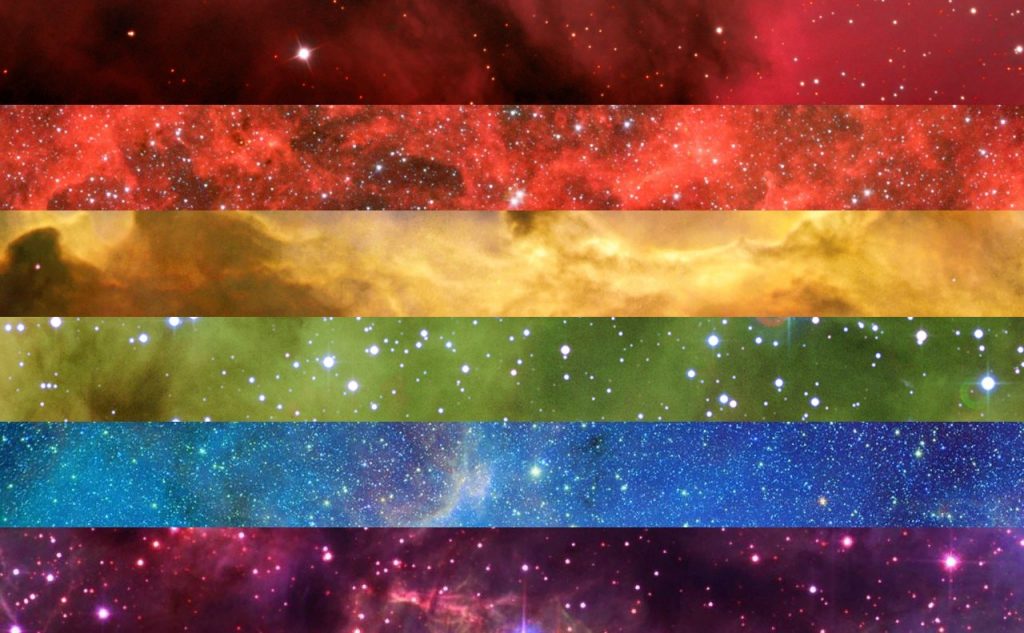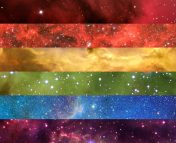
Author’s note: This piece references harassment and other potentially uncomfortable experiences.
“I would have been lost if not for this one, singular professor who made it her life’s work to get me to stay in astronomy.” That’s Fletcher Waller, a master’s student at the University of Victoria who uses spectroscopy to study populations of metal-poor stars in the Local Group, explaining why he’s still a scientist. Unlike more privileged individuals, his journey through astronomy has been shaped not just by his chosen specialty, but also by a fundamental part of his identity. Waller is transgender, and in a field that remains dominated by straight, cisgender white men, being queer often means constantly having to worry about harassment and abuse. While his supervisor went to extraordinary efforts to ensure that he felt supported, having a close ally is the exception, not the rule. As Waller puts it, “The department is so cis-het that it’s impossible to know who is even remotely safe to go to.”
I interviewed 14 current and former astronomers who identify as part of the LGBTQ+ community. Some, like Dr. Kaitlin Rasmussen, a spectroscopist at the University of Michigan, have survived bigoted environments through sheer determination. Others, faced with intense discrimination, have been forced out of astronomy entirely. Our conversations covered queerphobia in the field, resources for both LGBTQ+ astronomers and allies, and what individuals and institutions can do to provide safer and more inclusive environments. At a time when societal acceptance of the queer community is growing but significant structural barriers to equality remain, actions our field takes today are crucial to the survival of LGBTQ+ astronomers. Today, in the first half of this two-part Astrobite, I’ll introduce you to some of the folks I talked to, the challenges they face, and the ways astronomy has failed them so far.
What queer astronomers face
Dr. Claudia Antolini is a science communicator based in the United Kingdom. Antolini identifies as asexual, and throughout her years in academia, she experienced harassment from those who either didn’t understand her sexuality or simply didn’t care. She described having to run away and hide from men who continually made unwanted advances, summing up her experiences by saying, “I could tell you things that would make your skin crawl.”
Antolini’s encounters are far from atypical — both of women and of queer people in astronomy. I spoke with a former graduate student who asked a professor for a letter of recommendation for his PhD application while finishing his master’s degree. The professor told him “no one’s gonna hire [you] because [you’re] trans.” While the student eventually found a professor to do his PhD work with, this professor was disdainful after finding out about his transition; subsequently, he lost his funding and, subsequently, his apartment. He left astronomy, and has found it extremely difficult to reenter the field.
Some of the more insidious barriers queer astronomers face are those others view as trivial. Avery Kiihne, an undergraduate at Rutgers studying star formation in dwarf galaxies, encountered difficulties when changing their name. Administrative mishandling led to Kiihne having to use their deadname on certain forms seen by colleagues and supervisors, and they received an aggressive response when they tried to correct the matter. A problem that should have been solved in a day turned into a drawn-out, emotional ordeal.
Departments aren’t the only places where queer astronomers face the potential for discrimination, harassment, or assault. Conference organizers should be cognizant of the potential for meetings to be hostile environments. Recent legislation in certain states and jurisdictions has made it harder for nonbinary and transgender individuals to access the bathroom of their gender identity, which groups should take into account. International conferences should also strive to avoid regions where queerphobia is rampant. Winter Parts, a nonbinary PhD student at Penn State University studying exoplanets, brings up the example of a friend of theirs attending a conference in Dubai, where LGBTQ+ rights are nearly nonexistent. Parts was concerned about whether they could safely attend the conference.
Finally, there are the everyday microaggressions that slowly contribute to a climate of animosity. Waller faced hostile looks when he used gendered restrooms because his department lacked gender-neutral restrooms. One student I spoke to describes an instance they were told of where a professor made no effort to understand the purpose of properly using personal pronouns – an uncomfortable situation because of the potential for misgendering.
(Mis)understanding the queer community
When attempting to improve inclusivity, many astronomy departments treat LGBTQ+ astronomers as a singular, inseparable group — an assumption that is at best naive, and at worst actively harmful. As Antolini puts it, “The queer community is extremely varied, and all the different layers of the our full identities will take us down a very different path.” For example, being a person of color and gay is an extremely different experience than being white and gay. Nicole Man, now a data scientist at the Pacific Northwest National Laboratory, notes that overwhelmingly white queer spaces alienated her, saying, “I think my experience as a queer scientist and astrophysicist has also been tied with my identity as a woman of color. I think a lot of the times when I did try to be a part of the communities that were queer, I did feel like I had to fracture other parts of my identity in order to have some common ground with them.” At a time when astronomy departments are grappling with systemic racism in the field, ignoring intersectionality when working on inclusivity initiatives is a recipe for disaster.
A similarly problematic assumption is that all queer people are essentially the same; in reality, LGBTQ+ folks have varying needs. For example, transgender, intersex and nonbinary individuals urgently need gender-neutral restrooms — an issue most astronomy departments have utterly failed to address. Antolini points out that unlike other sexual orientations, asexuality is not a protected characteristic in the United Kingdom, meaning asexual folks may need additional departmental support for addressing academic harassment. It’s possible that a lack of representation of many queer groups throughout history and in modern media has contributed to this one-dimensional view of LGBTQ+ people. While gay astronomers and physicists can look up to the likes of Frank Kameny and Sally Ride, Antolini puts her own experience as an asexual scientist bluntly: “We have no Alan Turing.”
Finally, departments often fail to understand the importance of particular support systems in the queer community. Charlotte Olsen, a graduate student at Rutgers University working on distant galaxies, emphasizes the importance of a queer person’s “chosen family”, the individuals who support, comfort and care for them, particular in the absence of a normal family structure: “I think that there are times when the academy doesn’t recognize the importance of chosen family, because it’s not something that’s really super well understood. So, for example, participating in pride events or doing stuff at the local LGBT Center, people who participate in the balls or anything like that — a lot of times people who are outside of the gay community see these as hobbies, or special interests. . . . For some of us our chosen family is the only family that we have.”
Being queer in science entails an invisibility that other underrepresented minorities don’t face. The fact that you can’t tell whether someone is gay or trans or asexual just by looking at them can be both a blessing and a curse, a shield for individuals against potential harassment and a shield for institutions pretending or assuming that this harassment doesn’t exist at all. Unfortunately, some of the hostility incumbent in the current climate in astronomy compounds this invisibility by forcing queer astronomers to hide part of who they are. One PhD student I talked with says that while she is still not out, seeing other queer people thriving in the field brings her happiness and hope, and I hope that we can work towards a fully inclusive community, where more LGBTQ+ astronomers are able to enjoy this freedom. Tomorrow, I’ll look at what measures the field can take to better support queer astronomers, discuss some of the resources and support systems already in place, and take a peek down the path we can take to a more welcoming astronomy community.
Astrobite edited by Lili Alderson and Luna Zagorac.
Featured image credit: Laurie Raye


